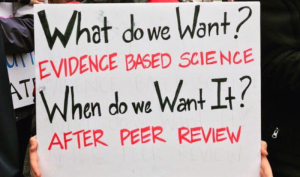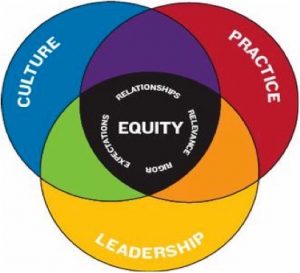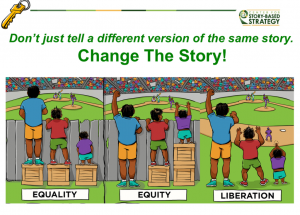This article by Rhonda Semple appears in the Winter 2017 edition of The Beacon
Even though I committed to writing this piece for the Beacon ages ago, and even though I care deeply about the subject of equity, it has taken me a long time to finally sit down to write. My research and teaching are deeply embedded in concerns over equity and, to be frank, my experience in those areas likely informs my reticence. On the one hand, as a historian of belief, my interests in decolonizing empires is a little radical for mission history. On the other hand, as a historian of religion, I’m a little suspect in feminist circles. In a similar manner, this will likely be too reductive for some colleagues and too complex for others. I will claim experience in being a woman although I’m neither expert at that nor can I claim expertise as a person in the many ‘equity seeking’ groups that contribute to an academic community.
I have, however, seen the CAUT studies that led our national union to state that “many academic staff face discrimination and harassment in their jobs. Women, Aboriginal persons and visible and ethnic minorities are under-represented, particularly amongst the most senior academic ranks. Academic staff with disabilities face significant hurdles. Lesbian, gay and bisexual academic staff often feel they must hide their sexuality out of fear of damaging their careers and transgender and transsexual academic staff face significant discrimination based on their gender identities” (https://www.caut.ca/issues-and-campaigns/equity). And I have heard about my female colleagues catcalled on campus and have had students, year on year, tell me about being racially harassed by their peers. I was sexually harassed by a gang of male students outside my house in the fall – threatened with anal rape on my own street because apparently that’s what a woman needs to shut her up.
I work in a province that roughly matches the national norm for a variety of problematic areas for women in the workforce: fewer women than men work in academe, women advance more slowly through the ranks than do our male colleagues, and women make less money.[1] I work on a campus where until yesterday (7 March) none of our named research chairs were held by a woman, where only one of our senior administrators is a woman or reflects other equity-seeking groups, and where we have not yet had a formal institutional commitment to equity as represented by an Equity Policy. “We believe in equity; we commit to equitable practices.” How hard is that? Do we not believe in equity? It has been nearly a year since we have had a Human Rights and Equity Advisor on campus, someone with the knowledge and experience to guide us towards productive solutions through what can be awkward and difficult discussions.
Talking about equity is straightforward in a certain sense. As an academic, my basic instinct is to rely on making sense of evidence through analysis and to build on peer-reviewed work to help make sense of that evidence. What the evidence shows, in modern British (imperial) history, is that when evidence is read ‘against the grain’ in formal archives and additionally, when evidence is collected outside of them, our analysis of the past is transformed. Historians like E.P. Thompson broadened the concept of who should be considered as having contributed to political and economic history.[2] Catherine Hall’s work indicates that viewing political revolution through a gendered lens enriches our understanding of how the trajectory from subject to citizen must include both men’s public contributions and the masculine respectability of supporting a family (thus excluding women).[3] Antoinette Burton points to how middle-class women, in claiming for themselves the right to vote, tended to exclude the contributions of working class women and built their case for suffrage on the backs of non-western women.[4] The masterful sociologist Stuart Hall slapped academics silly for ignoring culture and ethnicity in a Britain defined by its imperial past, and a range of young scholars have met the challenge to embed modern political culture in an important range of identities.[5] Lest this be dismissed as “history as a shopping list of cultural identities,” I would challenge you to explain why whiteness matters more than other imperial identities when analyzing citizenship and WWI, or to explain away the central meanings of recognizing yet silencing the interconnectedness of class difference, queerness, and militarized masculinity in the Household Guard – what is more British than the Guards? Seriously, identities other than white male and middle class matter, and to not acknowledge that is not just about inequities. It is just bad history.
I know about and can participate in the debates in my discipline. It is more difficult to discuss race, diversity, and equity at work – but not to do so results in a bad work environment. Since we all think for a living, we could apply that critical lens to our workplace, innovate, and be leaders in equity. The subject is complex. And just as my students struggle with understanding their own place (and how it relates to the past), I do the same. A lot of times I don’t want to deal with the discomfort of challenging norms, and I often can make the choice not to. But not everyone can. For example, like many others, some of our colleagues and other people I care about were floored by Trump’s election. One colleague in particular felt very threatened by a group of male students wearing Trump hats on campus that week. Yes, they had the right to do so, but by doing so they were communicating particular notions. Is our colleague a ‘snowflake’? I don’t think so. Trump spilled a lot of vitriol against various equity-seeking groups during the election. His supporters lapped that up, and he’s done nothing to counter the hatefulness subsequently. So that week was difficult for a lot of people. To put it in context, my queer acquaintances receive hateful and threatening letters in their mailboxes and check the mail knowing that could happen any day. I don’t. A gay man from Pictou was left paralyzed from a beating he received a few years ago. My gay friends make travel plans with a view that going to the wrong country could result in physical harm, incarceration, or death. That is not the reality of someone who is weak, although it is living besieged. The limited amount of CAUT data available indicates those negative experiences are compounded in academia.[7] How do we define people whose identity and privilege doesn’t match our own? ‘Fit’. ‘We just need to see if it’s a good fit,’ which is a just murky enough description that it can mean anything.
And it isn’t just difficult to act because of my own privilege; in writing this, I struggle with how to communicate equitable practice to an audience that might not want to hear it. It is important to be able to identify our own privilege in order to acknowledge it, note inherent inequities, and then mobilize for change. The most difficult place from which to note inequity is from a place of privilege. Did you open the footnote about the gender pay gap above and see it was roughly $8000 per annum in 2006? Did you think “aw, not that bad” or “argh, that’s irritating?” The answer will speak to your degree of privilege – or lack thereof – as well as your ability to empathize. It is not about feeling guilty and it is not about explaining away privilege. It is about listening and responding.
StFX can reach a better potential by mobilizing privilege to structurally reshape norms that enshrine inequalities, through individual choice, by the institution naming problems, and by shifting practice.[8] We did participate in a facilitated forum nearly two years ago where challenges were identified and some solutions initiated. Our institution has decided to make equity and inclusion one of the five pillars of our strategic plan and it remains to be seen what that means exactly. How can we listen? There exists a joint administration-union equity implementation committee which did not meet this year and while the Priorities Framework document released with the 2017-2018 Strategic Plan noted that an “equity review” has been initiated, and that a revised version of the Harassment and Discrimination policy has been developed, at the very least there doesn’t seem to have been broad-based engagement in our institution regarding these initiatives.
Of course there are initiatives being undertaken in our institution and I have certainly seen change in the past ten years. Making real change is also complex, as the CAUT literature suggests – but requires reshaping culture and shifting practice. So what can we do? Women and other equity-seeking groups are likely not the focus of systematic exclusion but they are under-represented – as students, as Faculty, in certain disciplines and in Administration. When individuals have to advocate for their interests in the face of what is ‘normalized’ but actually excludes them, we need to act. Sitting on CoN, I helped replace individuals on committees who could not fulfill their committee contributions because the committee members suggested meeting during family-centered parts of the day. So, one solution is to step up and state it is not a good time of the day – that is what a professional should do. You might do so, but that gets tiresome. A culture of inclusion includes colleagues who do not make the lone voice say “it is not a good time for me.” We all work at night, but when I write or grade at home, I can clean up the kitchen and help with homework before turning to my own work. Sitting in a seminar room on campus is quite different.
An equitable institution requires we act decisively, build capacity in the university, and build meaningful partnerships with local community members. I know the university has recently invited the Band Chief from the local Mi’kmaq community to join the Board of Governors. We have also seen a much larger and more diverse attendance on campus events for Mi’kmaq History month and when Mawiomi’s are organized, and community members from Paq’tnkek have joined the StFX community for the Take Back the Night March for a couple of years. Alan Syliboy was a welcome presence on campus last fall as Coady Chair in Social Justice, and the visit of the Honourable Murray Sinclair and the related events was both a challenge and inspiring. I will never forget our student presenting Senator Sinclair with a memento of her grandmother, a Residential School survivor, who did not get to share her story with him. That presentation closed a circle between past and present, her family and community, students, and our school and purpose.
But we need to build on these initiatives, think carefully as we move forward, and continue to communicate our commitment clearly. We have one committee on campus – CABSS – where Faculty and Staff, Students, Advisors, Administrators, and Community members meet together. For several years the committee has picked away at a variety of issues but for the most part I would say we share stories and work on pieces of change without being able to affect systematic transformation. We have not developed a policy whereby we focus recruiting efforts in equity-seeking communities. Although the new and welcome funding initiatives from the Deveau Fund are supporting students and new teaching initiatives, students consistently point out that the very Xaverian spirit we celebrate and lean on for recruiting tends to exclude non-traditional students. Further, this year there have been several moments that contributed to a dampening down of hope for collaboration. While we have begun to acknowledge formally and wrestle with the meaning of our community’s locale in Mi’kmaqi, as an institution we have chosen to both fly the Mi’kmaq flag but then take it down again. My understanding is that local elders have expressed deep concern over this choice. Students organized a petition in support of flying the flag and the student newspaper has been provoking debate on a variety of related issues all year.[10] The administration counters that policy is required as well as a place to fly the flag. This policy is taking a long time, however. Given that there are empty flag spots on Morrison, a flag could be flown there temporarily until another locale is decided upon. Additionally, in our province the need to ‘develop flag policy’ has served as code for keeping flags (such as Pride Flags) off municipal buildings so it is hard for advocates in equity-seeking communities not to read administrative language in that light. We are currently being consulted as a community about this effort. Yet if this is indeed unceded territory – historically, legally, and ethically – this can happen, so really this further signals the authority of an institution of higher learning over traditional rights.
Further to these concerns, along with creating new programs and accepting funds to build a new building, we have accepted Brian Mulroney’s office materials, including the desk gifted to him by his party that was owned by Sir John A. Macdonald. While Richard Gwyn may dismiss concerns over the celebration of Macdonald – apparently naming aboriginal peoples “problems” is not a problem[11] – as academics it is our job to problematize meanings and communicate our findings. Maybe there is an intention that is going to happen (at a conference? In a collection of essays? Through art installations?), but I am a concerned listener, and I have not yet heard about those intentions. Again, we think and teach for a living. We can say many thanks to donors for supporting our programs and build programs that teach students to think critically, and in particular lead debates that historicize the founding of our country against the resulting material and cultural meaning of that institution for aboriginal communities and us all. Our 150 year anniversary is a perfect time to do this, and if we are an institution committed to equity, then we should act.
There are many problems pointed out here. There are difficult decisions to be made, but some solutions are dead easy. Some Faculty committees commit to meaningful contributions: last year we were represented by a female Union President, the Chair of General Faculty is another formidable woman, and women have been represented as Chair of Senate and as members of its steering committee recently. We can educate ourselves as Faculty about the culture that slows success of equity-seeking groups in being hired, applying for and getting research chairs, and in promotion. Our institution can promote equity formally, by supporting equitable recruitment, by formally acknowledging equity in promotion and tenure, and perhaps by partnering with CAUT in hosting some of the in service programs the organization has developed.
And one final but important note. Apparently Verdana is not a particularly popular font. I can’t say that I’ve ever felt strongly about a font unless it is 1 a.m. and it makes the next paper to grade difficult to read. However, for people who have dyslexia, it is one of the fonts that is easier to read than others.[12] We all read and write a lot in our jobs. When we write to communicate to our students I would suggest we choose to use one of the dyslexia-accessible fonts. If students with dyslexia (and their fees) are welcomed into our institution and we do not meet their learning needs, I would suggest they are like the short purple-shirted kid in the first image on the left below that I’m sure we’ve all seen. S/he’s sitting in your class but actually reading the syllabus the first day is a challenge. Adapting your teaching to this student promotes equality of access and is illustrated in the middle image. You can print a syllabus off for her/him in Verdana and make sure it is handed out to the right person that first day and it might very well make their life a lot easier. However, if you make a systematic institutional change by shifting your default to Verdana, you will never need to think about it again. The students without dyslexia probably will not even notice – but the person who can benefit will, and you will no longer need to act in a conscious, “exceptional” manner for the benefit of one student. That’s the third picture, where the institutional choice that benefits the tall dude ceases to be a problem for anybody. The barrier just ceases to exist.
I accept that this is a symplistic example, although if my student offspring had dyslexia I would welcome an explanation as to why he didn’t deserve similar treatment. And if you are reading this and thinking of the many more complex situations offering evidence as to why you should not use Verdana, or why the institution shouldn’t tell you to teach or act inclusively, or how irritating it is for a Historian to be nattering on at you about your professional life, then maybe the problem with equity is you.[14]
[1] The Persistent Gap: Understanding male-female salary differentials amongst Canadian academic staff (March 2011)
[2] E.P.Thompson The Making of the English Working Class (New York: Vintage, 1963).
[3] Catherine Hall, White Male and Working Class (London: Wiley, 1992).
[4] Antoinette Burton, Burdens of History (Raleigh: UNCPress, 1994).
[5] Matt Houlbrook, ‘Soldier Heroes and Rent Boys: Homosex, Masculinities and Britishness in the Brigade of Guards, c.1900-60’, JBS 42:3 (July 2003): 351-88.
[6] http://gizmodo.com/why-scientists-are-planning-their-own-march-on-washingt-1791618754
[7] A Partial Picture: The representation of equity-seeking groups in Canada’s universities and colleges (November 2007)
[8] http://www.communichi.org/racial-equity-diversity-awareness/
[9] https://ljwalsh123.files.wordpress.com/2016/10/img_6216.jpg
[10] http://www.xaverian.ca/articles/2016/11/27/6b88h4zfplr89uhl4iamx6n1kvs7lf
[11]https://www.thestar.com/opinion/commentary/2014/02/06/sir_john_a_macdonald_made_mistakes_but_he_wasnt_a_racist_gwyn.html
[12] http://dyslexiahelp.umich.edu/sites/default/files/good_fonts_for_dyslexia_study.pdf
[13] Artwork by Angus Maguire. interactioninstitute.org madewithangus.com
[14] It’s me too.



